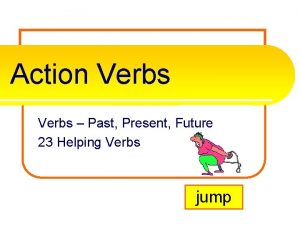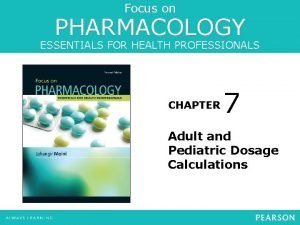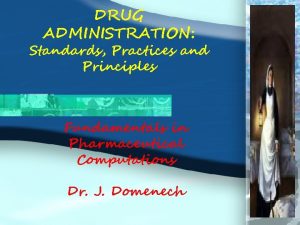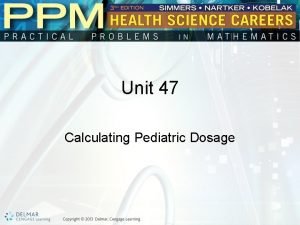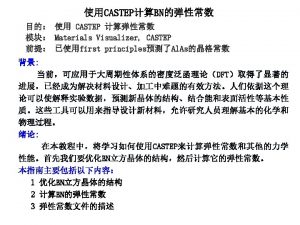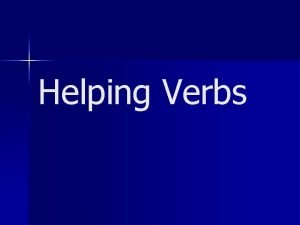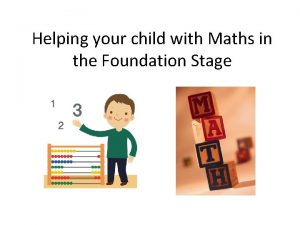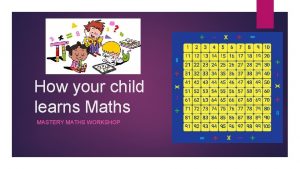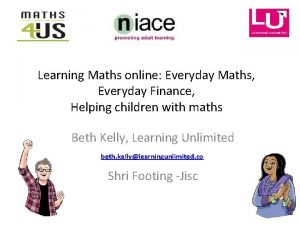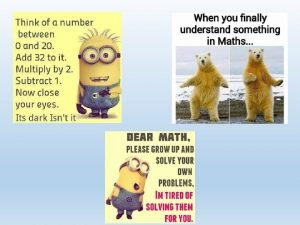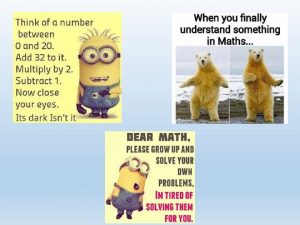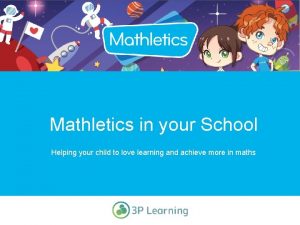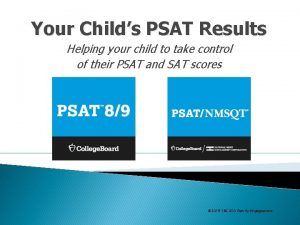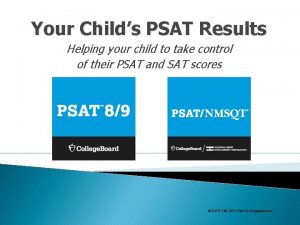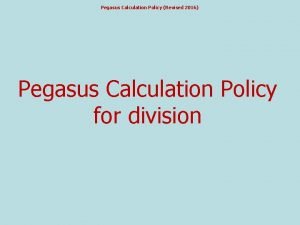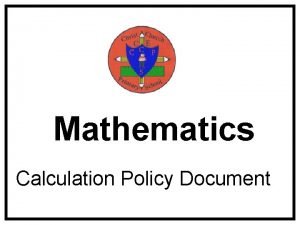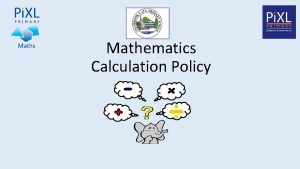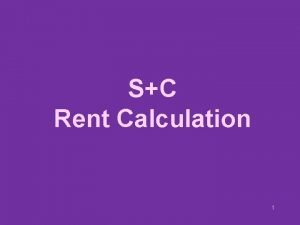Helping your child with maths CALCULATION The maths



















- Slides: 19

Helping your child with maths

CALCULATION The maths work your child is doing at school may look very different to the kind of ‘sums’ or maths work you remember. Children are encouraged to work mentally, where possible, using personal jottings to help support their thinking. Even when children are taught more formal written methods (from year 3 onwards), they are only encouraged to use these methods for calculations they cannot solve in their heads. Discussing the efficiency and suitability of different strategies is an important part of maths lessons. Talk to your child about how you work things out. Ask your child to explain their thinking.

When faced with a calculation, encourage your child to ask… • Can I do this in my head? • Could I do this in my head using drawings or jottings to help me? • Do I need to use a written method? • Should I use a calculator? Also help your child to estimate and then check the answer. Encourage them to ask… Is the answer sensible?

ADDITION Children are taught to understand addition as combining two sets and counting on. 2+3= At a party, I eat 2 cakes and my friend eats 3. How many cakes did we eat altogether? 5 cakes 7+4= 7 people are on the bus. 4 more get on at the next stop. How many people are on the bus now? Children can use physical objects to help them count, In this case, we have used cakes. Children could draw a picture to help them work out the answer. This addition method uses physical objects and is an expected outcome for children in Year 1. The numbers are already there on the number line for the children. They start on the first number, in this case 7, and count on 4. So 8, 9, 10 and then 11. It is important to explain to the children that the first number, 7, is not included in the count. This addition method is an expected outcome for children in Year 1. 47+25= My sunflower is 47 cm tall. It grows another 25 cm. How tall is it now? Drawing an empty number line helps children to record the steps they have taken in a calculation (start on 47, +20, and then +5). This is much more efficient than counting on in ones. My sunflower is now 72 cm tall. This addition method uses a blank number line and is an expected outcome for children in Year 2.

ADDITION 487+546= There are 487 boys and 546 girls in a school. How many children are there altogether? 546 487 + 13 120 900 1033 There are 1, 033 children altogether. 12, 786 + 2, 568= 12, 786 people visited the museum last year. The numbers increased by 2, 568 this year. How many people altogether visited this year? 1 2, 7 8 6 2, 5 6 8 + 1 5, 3 5 4 111 8. 134 + 1. 086= 8. 134 million people live in London and 1. 086 people live in Birmingham. How many people altogether live in these cities? 8. 134 1. 086 + 9. 220 11 Children will be taught written methods for those calculations they cannot do ‘in their heads’. Expanded methods build on mental methods and make the value of the digits clear to children. The language used is very important. (6+7, 40+80, 500+400, and then 900+120+13 – add this mentally NOT in columns). This addition method is called the expanded column method and is an expected outcome for children in Year 3. When children are confident using the expanded method, this can be ‘squashed’ into the traditional compact (standard) method. This addition method is the compact column method and is an expected outcome for children in Year 4. In Year 5, larger numbers are introduced, but this method will still be used. Adding decimal numbers still involves the compact (standard) method, but it is important to ensure all decimal points are lined up first. In doing this, the children can then just get on with the adding part. This addition method is an expected outcome for children in Year 6.

SUBTRACTION Children are taught to understand subtraction as taking away (counting back) and finding the difference (counting up) 5– 2= Drawing a picture helps children to I had five balloons. Two burst. How visualise the problem. many did I have left? Take away The children could use physical objects. In this case, we have used 5 balloons and burst 2 of them to find the answer. A teddy bear costs £ 5 and a doll costs £ 2. How much more does the bear cost? Find the difference 7 -3= 7 people are on the bus. 3 people get off at the next stop. How many people are left on the bus now? This subtraction method uses physical objects to take away and is an expected outcome for children in Year 1. This approach uses a numbered number line to help the children count up to a number, in order to calculate the difference So in this case, children start on 3 and count on to 7. So 4, 5, 6 and 7 = 4 It is important to explain to the children that the first number, 3, is not included in the count. This approach is an expected outcome for children in Year 1. 73 -30= +10 30 +10 40 50 +10 60 70 This stage utilises a blank number line and encourages children to jump in multiples of ten to solve a calculation more efficiently by counting on. +3 73 This method should be secure by the end of Year 2.

SUBTRACTION 83 -38= This involves partitioning the tens and units initially. 80 30 3 8 - Then exchanging if needed. In this case we need to, as you cannot do 3 -8. 70 80 30 40 13 3 8 5 = 45 146 -79= 0 13 16 146 79 6 7 You could not do 6 -9 so you needed to exchange from the next column to make it 16 -9. You then could not do 3 -7 so you had to exchange from the next column to make 13 -7. Finally, this leaves 0 in the final column which we do not need. This introduces the concept of column subtraction, but in an expanded form. The expanded form appears complicated, however this method is crucial in ensuring children develop a secure understanding of the place value of numbers. Without this understanding, they will struggle to solve reasoning problems as they will only have an understanding of how to use the method, rather than the maths involved in it. This method should be secure by the end of Year 3. This now introduces the standard column method that you may be most familiar with when subtracting. It involves exchanging when needed. From the previous stage, children should understand what they are exchanging. This method should be secure by the end of Year 4. It will also be consolidated in Year 5.

SUBTRACTION 13. 3 – 7. 77 = 0 12 12 10 1 3. 3 0 7. 7 75. 53 Notice the place holder has a 0 in it, which can be inserted if the space is previously blank. This helps us complete the subtraction. This method should be secure by the end of Year 5. It will also be consolidated in Year 6. Children continue to use the standard column method, but with larger numbers. They will also progress to using this method to subtract decimal numbers of different sizes. This stage introduces the concept of a place holder. You could not do 0 -7 so you needed to exchange from the next column to make it 10 -7. You then could not do 2 -7 so you had to exchange from the next column to make 12 -7. Finally, this leaves 0 in the final column which we do not need. BONUS SUBTRACTION METHOD £ 20. 00 - £ 7. 79 You could do lots of exchanging to work out this answer, but there is a quicker, more effective way if there is a lot of exchanging involved. It involves taking 1 p away from the top and the bottom. Which leaves: £ 19. 99 7. 78 £ 12. 21 This is a really effective trick that can be applied in all year groups. When faced with a question involving calculating change, for example I spend £ 7. 78 and I pay with a £ 10 note, how much change do I receive, or 2000 - 1779, many children will immediately apply a column subtraction method. This works, but it involves a lot of exchanging which provides many opportunities to make a mistake. This bonus method provides a little trick to help make these style of calculations a LOT easier.

MULTIPLICATION Children are taught to understand multiplication as repeated addition and scaling. It can also describe an array. 2 x 4= Again a picture can be useful. Each child has two eyes. How many eyes do four children have? Children are taught to solve on-step problems involving multiplication by calculating the answer using objects and pictorial representations. 2 + 2 + This method should be secure by the end of Year 2. 2 Four children have 8 eyes altogether. 5 x 2= This is 5 groups of 2 so we need to do the 2 x tables up to 5 x 2. We therefore need to make 5 jumps of 2. 0 2 4 6 179 x 8 = 179 8 x 72 560 800 1432 1 (8 x 9) (8 x 70) (8 x 100) 8 This method should be secure by the end of Year 2. 10 Children are taught the expanded column method. This method is very similar to the standard column method, however the answer to each column is written out in full. This helps consolidate an understanding of place value before progressing to the standard method. This method should be secure by the end of Year 3 and will be consolidated in Year 4.

MULTIPLICATION Children are taught to understand multiplication as repeated addition and scaling. It can also describe an array. 129 x 8= In stage 4, children progress to the standard long multiplication method, but with questions that only multiply by one digit. 129 8 x 1032 27 You have to use the carrying method here. 8 x 9=72 so the 2 is kept and the 7 is carried. Then, 2 x 8=16 added to the carried 7 is 23 so the 3 stays and the 2 is carried. Finally, 1 x 8=8 added to the carried 2 = 10 and that is put into the answer as there are no more steps left to take. 6 x 124 = The single digit goes down the left hand column. And the bigger number is partitioned along the top column. You then can multiply the different numbers together in order. x 100 20 4 6 600 120 24 = 744 72 x 34 = A piece of string is 72 cm long. A rope is 34 times longer. How long is the rope? x 70 30 2100 4 280 2 60 8 2160 288 + 2448 1 This method should be secure by the end of Year 4. The children will also learn the grid method. This method should be secure by the end of Year 4. The grid method can also be used to multiply larger numbers together. This method should be secure by the end of Year 5.

MULTIPLICATION Children are taught to understand multiplication as repeated addition and scaling. It can also describe an array. 12 x 43= 12 43 x 36 480 516 It is important that the children add in the 0 for the second row of multiplication to show that they are multiplying by the tens column. 4. 87 x 3 = For this, you can first work out what the answer would be without a decimal point. 487 3 x 1261 22 Then, you need to add the decimal point back in. In order to do this accurately, just count how many decimal places were in the question. In this case it was 2 DP so the answer is 12. 61 the children continue the standard long multiplication method, by multiplying with numbers larger than 1 digit. This method introduces the concept of a place holder and it's important children understand that this place holder is added because we are multiplying by the tens column. This method should be secure by the end of Year 5. Children learn to multiply whole numbers by decimals using the standard long multiplication method. Multiplying decimals is the same as multiplying whole numbers. The trick is to count the number of digits after the decimal point in the question. This will be the number of decimal places in the answer. This method should be secure by the end of Year 6.

DIVISION Children are taught to understand division as sharing and grouping. 6÷ 2 = 6 colouring pencils are shared between 2 children. How many pencils do they get each? Sharing between 2 There are 6 colouring pencils. How many children can have two each? More pictures! Drawing often gives children a way into solving the problem. Children solve one-step problems involving division by calculating the answer using objects and pictorial representations. The key difference between this method and the next stage is that for this method children are taught that division is the concept of sharing. End of year expectation for Year 2 Grouping in 2 s 12 ÷ 4 = 4 apples are packed in a basket. How many baskets can you fill with 12 apples? Dots or tally marks can either be shared out one at a time or split up into groups. Groupings in 4 s leaves 3 groups. End of year expectation for Year 2

DIVISION Children are taught to understand division as sharing and grouping. 28 ÷ 7 = A comic costs 7 p. How many can I buy with 28 p? Children are taught to use a number line to support them in solving a division calculation. The purpose of a number line is to help children visualise the relationship between multiplication and division, and how they are inverse operations. End of year expectation for Year 3 0 7 14 21 28 545 ÷ 5 = 1 0 9 5 5 4 45 As you can see from the middle number, 5 cannot go into 4 so you put a 0 into your answer and carry that 4 over. The children are taught the formal short method of division. It's important to remember the place value of numbers in this calculation, for example it's not how many 4 s go into 5 because that 5 is worth 5 hundreds. End of year expectation for Year 5

DIVISION Children are taught to understand division as sharing and grouping. Children are taught the formal method of long division. It is an expectation that all children at the end of Year 6 will be secure with this method. This method does look complicated, however if you follow the steps carefully it is pretty straight forward. To use this method securely, children need to have a secure understanding of doubling and halving strategies, illustrating the importance of securing these skills at a young age.

REAL LIFE PROBLEMS Go shopping with your child to buy two or three items. Ask them to work out the total amount spent and how much change you will get. Buy some items with a percentage extra free. Help your child to calculate how much of the product is free. Plan an outing during the holidays. Ask your child to think about what time you will need to set off and how much money you will need to take. Use a TV guide. Ask your child to work out the length of their favourite programmes. Can they calculate how long they spend watching TV each day / each week? Use a bus or train timetable. Ask your child to work out how long a journey between two places should take? Go on the journey. Do you arrive earlier or later than expected? How much earlier/later? Help your child to scale a recipe up or down to feed the right amount of people. Work together to plan a party or meal on a budget. These are just a few ideas to give you a starting point. Try to involve your child in as many problem-solving activities as possible. The more ‘real’ a problem is, the more motivated they will be when trying to solve it.

PRACTISING NUMBER FACTS Find out which number facts your child is learning at school (addition facts to 10, times tables, doubles etc). Try to practise for a few minutes each day using a range of vocabulary. Have a ‘fact of the day’. Pin this fact up around the house. Practise reading it in a quiet, loud, squeaky voice. Ask your child over the day if they can recall the fact. Play ‘ping pong’ to practise complements with your child. You say a number. They reply with how much more is needed to make 10. You can also play this game with numbers totalling 20, 100 or 1000. Encourage your child to answer quickly, without counting or using fingers. Throw 2 dice. Ask your child to find the total of the numbers (+), the difference between them (-) or the product (x). Can they do this without counting? Use a set of playing cards (no pictures). Turn over two cards and ask your child to add or multiply the numbers. If they answer correctly, they keep the cards. How many cards can they collect in 2 minutes? Play Bingo. Each player chooses five answers (e. g. numbers to 10 to practise simple addition, multiples of 5 to practise the five times tables). Ask a question and if a player has the answer, they can cross it off. The winner is the first player to cross off all their answers. Give your child an answer. Ask them to write as many addition sentences as they can with this answer (e. g. 10 = �+ �). Try with multiplication or subtraction. Give your child a number fact (e. g. 5+3=8). Ask them what else they can find out from this fact (e. g. 3+5=8, 8 -5=3, 8 -3=5, 50+30=80, 500+300=800, 5+4=9, 15+3=18). Add to the list over the next few days. Try starting with a multiplication fact as well.

SHAPES AND MEASURES • Choose a shape of the week e. g. cylinder. Look for this shape in the environment (tins, candles etc). Ask your child to describe the shape to you (2 circular faces, 2 curved edges. . . ) • Play ‘guess my shape’. You think of a shape. Your child asks questions to try to identify it but you can only answer ‘yes’ or ‘no’ (e. g. Does it have more than 4 corners? Does it have any curved sides? ) • Hunt for right angles around your home. Can your child also spot angles bigger or smaller than a right angle? • Look for symmetrical objects. Help your child to draw or paint symmetrical pictures / patterns? • Make a model using boxes/containers of different shapes and sizes. Ask your child to describe their model. • Practise measuring the lengths or heights of objects (in metres or cm). Help your child to use different rulers and tape measures correctly. Encourage them to estimate before measuring. • Let your child help with cooking at home. Help them to measure ingredients accurately using weighing scales or measuring jugs. Talk about what each division on the scale stands for. • Choose some food items out of the cupboard. Try to put the objects in order of weight, by feel alone. Check by looking at the amounts on the packets. Practise telling the time with your child. Use both digital and analogue clocks. Ask your child to be a ‘timekeeper’ (e. g. tell me when it is half past four because then we are going swimming). • • Use a stop clock to time how long it takes to do everyday tasks (e. g. how long does it take to get dressed? ). Encourage your child to estimate first.

COUNTING IDEAS Practise chanting the number names Encourage your child to join in with you. When they are confident, try starting from different numbers – 4, 5, 6 … Sing a number rhyme together – there are lots of commercial CD’s available. Give your child the opportunity to count a range of interesting objects (coins, pasta shapes, buttons etc. ) Encourage them to touch and move each object as they count. Count things you cannot touch or see (more difficult!!). Try lights on the ceiling, window panes, jumps, claps or oranges in a bag. Play games that involve counting (e. g. Snakes & Ladders, dice games, games that involve collecting objects). Look for numerals in the environment. You can spot numerals at home, in the street or when out shopping. Cut out numerals from newspapers, magazines or birthday cards. Then help your child to put the numbers in order. Make mistakes when chanting, counting or ordering numbers. Can your child spot what you have done wrong? Choose a number of the week e. g. 5. Practise counting to 5 and on from 5. Count our groups of 5 objects (5 toys, 5 bricks, 5 pens). See how many places you can spot the numeral 5.

ENJOYING MATHS TOGETHER
 All 23 linking verbs
All 23 linking verbs Who is helping your mother
Who is helping your mother Fried's rule formula
Fried's rule formula Pediatric dose calculation formula
Pediatric dose calculation formula Body surface area dose formula
Body surface area dose formula Left child right child tree representation
Left child right child tree representation Give us your hungry your tired your poor
Give us your hungry your tired your poor Hát kết hợp bộ gõ cơ thể
Hát kết hợp bộ gõ cơ thể Bổ thể
Bổ thể Tỉ lệ cơ thể trẻ em
Tỉ lệ cơ thể trẻ em Voi kéo gỗ như thế nào
Voi kéo gỗ như thế nào Tư thế worms-breton
Tư thế worms-breton Alleluia hat len nguoi oi
Alleluia hat len nguoi oi Các môn thể thao bắt đầu bằng tiếng bóng
Các môn thể thao bắt đầu bằng tiếng bóng Thế nào là hệ số cao nhất
Thế nào là hệ số cao nhất Các châu lục và đại dương trên thế giới
Các châu lục và đại dương trên thế giới Cong thức tính động năng
Cong thức tính động năng Trời xanh đây là của chúng ta thể thơ
Trời xanh đây là của chúng ta thể thơ Mật thư anh em như thể tay chân
Mật thư anh em như thể tay chân
